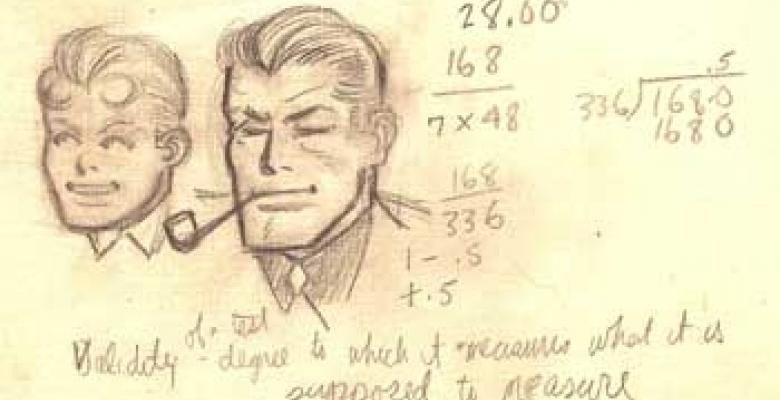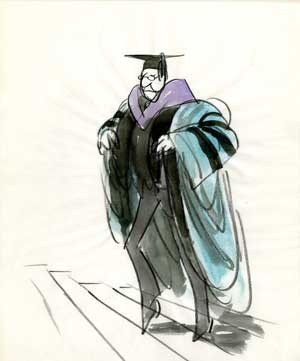Comics Exhibition Carries a Wallop


Pow! Bam! Zap! Columbia has surprising, even eye-popping, connections to comic book superheroes.
This and much else are evident in a show at the Rare Book & Manuscript Library called “Comics at Columbia: Past, Present, Future,” running through January 23, which shines a spotlight on Columbia’s acquisition of cartoonists’ archives, illustrations, manuscripts and comics. It features items ranging from recent graphic novels to a cartoon penned in 1766, when Columbia was still King’s College.
“The show demonstrates how comics have permeated Columbia’s archival collections for decades,” said Karen Green, librarian for Ancient & Medieval History and Graphic Novels. “It also shows the enormous diversity of the medium and how it reflects social and political history, making it a wonderful resource for research and teaching.”
Few would guess that the creator of Wonder Woman, William Moulton Marston, was a lecturer in psychology at Columbia in the late 1920s. He hoped the golden-lasso wielding super-heroine, first introduced as a character in 1941, would inspire girls as much as Superman had inspired boys. Two decades later, Jerry Robinson, an early Batman artist, doodled an introductory illustration of Batman and Robin’s true identities, Bruce Wayne and Dick Grayson, as he sat in a Columbia College psychology class.
Beyond the work of Robinson, a sketch of the Man of Steel by creator and artist Joe Shuster is in Columbia’s collection. So proud of his creation was Shuster that he printed stationery with the letterhead “Artist-Creator of Superman,” staking his ownership to the faster-than-a-speeding-bullet superhero. That stationery is in the exhibit, too.
Other DC Comics-related holdings include ballooned and lettered art from Paul Levitz, a former president of DC who wrote for “Legion of Super Heroes.” Levitz was among the comics and graphic arts luminaries attending the opening of the exhibition in October, along with Mad magazine legend Al Jaffee, who donated his archive to Columbia in 2013, and longtime X-Men writer, Chris Claremont, who is widely credited with making the comic a bestseller and whose work is also in the show.
Columbia itself stars in a Daredevil issue that features a scene in which the ninja assassin, Elektra, recalls her time as a student complete with a flashback that includes Low Library and Alma Mater. In the same comic, the superhero Daredevil flips over the bronze statue of The Great God Pan, which has had many homes on campus, but now reclines on the Lewisohn Hall lawn.
Running the gamut from the Justice League to the Ivy League, the show offers many surprises. Rube Goldberg, known for drawings of outlandishly elaborate contraptions, has an editorial cartoon that was submitted as part of the dossier that won him a Pulitzer Prize for political cartooning in 1948. He inscribed the cartoon to Columbia’s first Journalism School dean, Carl Ackerman.
Truly unexpected are racy cartoons by Thomas Merton (CC’38). His drawings for the undergraduate humor magazine, the Columbia Jester, add the word “cartoonist” to his many other appellations: Trappist monk, priest, mystic, activist, and writer.
Equally surprising is how Peter Kuper, who is known in part for Mad magazine’s “Spy vs. Spy” drawings, has worked on great literature as well; in particular, illustrating the haunting works of Franz Kafka. “Peter’s Kafka adaptations are an indication that cartoonists have a wide range of inspirations, and don’t subsist on comics alone,” said Green.
Comics can serve various roles. Thomas Nast, whose cartoons helped topple the corrupt Tammany Hall politician, William “Boss” Tweed, has drawings in the show, as is an adaptation of Al Capp’s comic strip Li’l Abner, published in an American military journal meant to entertain the troops in World War II. Comics also tackle societal problems such as high school drug abuse in a Harvey comic that was co-published with Columbia University Press.
A costume of Marvel’s Red Sonja, worn by Wendy Pini, the co-creator of Elfquest comics, is also in the exhibition. It is a very early example of the activity now called “cosplay,” a term that refers to dressing up for costumed role-play. “She didn’t merely dress up as Sonja, she inhabited the character, as contemporary cosplayers do,” said Green.
Columbia started buying graphic novels for the circulating collection in 2005. Although there have been comics materials in the archives for decades, Green started acquiring them systematically in 2011. The speed with which the library has done so shows how far it has leaped, like Superman, in a single bound.